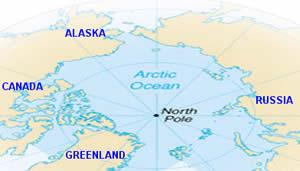
| Introduction
It is hypothesized that the nomadic Inuit people originated in northeastern Siberia. Some time around 2,000 BC they began to migrate eastward across the Bering Straits to Alaska and then across northern Canada to Greeenland. This migration may have taken as long as 1,000 years. Today, most Inuit people have given up their nomadic lifestyle and live in settled communities. The name Inuit means "the people." Eskimo is a derogatory word in Algonquian which means "eater of raw flesh."
 The Eskimo-Aleut family consists of a continuum of languages/dialects spoken by close to 100,000 (150,000 in some estimates) people who live in Alaska, Canada, and Greenland, and in an area stretching along the Aleutian Islands into Siberia. It is one of the most geographically spread language families in the world. Status
According to Ethnologue, there are 11 members of the Eskimo-Aleut language family, one of them extinct, that can be classified into three branches: Aleut, Eskimo, and Yupik. The table below shows the names of the language varieties, number of speakers, and geographic distribution. Greenland and Denmark have the largest number of speakers (about 54,000), followed by Canada (about 35,000). The language is all but extinct in Russia with only a thousand or so speakers remaining. Aleut |
|---|
| Aleut | 300 | Aleutian Chain, Pribilofs, Alaskan Peninsula. Also spoken in Russia. | Eskimo |
|---|
| Inupiatun, Northern Alaskan (Inupiat, "Eskimo") | 8,000 | Norton Sound and Point Hope, Alaska. Also spoken in Canada | | Inupiatun, Northwest Alaskan | 4,000 | Alaska, Kobuk River, Noatak River, Seward Peninsula, and Bering Strait. | | Inuktitut, Eastern Canadian | 14,000 | West of Hudson Bay and east through Baffin Island, Quebec, and Labrador. | | Inuktitut, Western Canadian | 4,000 | Central Canadian Arctic, and west to the Mackenzie Delta and coastal area | | Inuktitut, Greenlandic (Kalallisut) | 47,800 | Greenland, Denmark | Yupik (Inupiaq) |
|---|
| Alaskan | | Yupik, Pacific Gulf | 400 | Alaska Peninsula, Kodiak Island | | Yupik, Central | 10,000 | Nunivak Island, Alaska coast from Bristol Bay to Unalakleet on Norton Sound and inland along Nushagak, Kuskokwim, and Yukon rivers. | | Siberian | | Yupik, Central Siberian | 1,050 | St. Lawrence Island, Alaska; Gambell and Savonga villages, Alaska. Also spoken in Russia. | | Yupik, Naukan | 75 | Chukotka Peninsula, Russia | | Yupik, Sirenik | extinct | Chukotka Peninsula, Russia |
- Inuktitut is recognized as an official language in Greenland (along with English). It is taught in schools, and as a result, literacy rates there are quite high. Inuktitut is also used in electronic and print media.
- In Canada, Inuktitut is recognized as the official language of Nunavut Territory (along with English and French) and the Northwest Territories (along with English, French, and several other indigenous languages). It also has legal recognition in Nunavik - a part of Quebec - where it is recognized in the Charter of the French Language as the official language of instruction for Inuit schools. It also has some recognition in Nunatsiavut - the Inuit area of Labrador. The Canadian Broadcasting Corporation has Inuktitut broadcasts. Inuktitut is also used in print media. The Inuit Circumpolar Conference has a commission dedicated to the preservation of Inuit and the development of a common writing system for the language.
- In the U.S., Yupik is rarely taught in schools with the inevitable result of low literacy rates and language loss.
- In Russia, Yupik is a dying language with only about 1,000 speakers left.
¡@
|
 Introduction
Introduction




